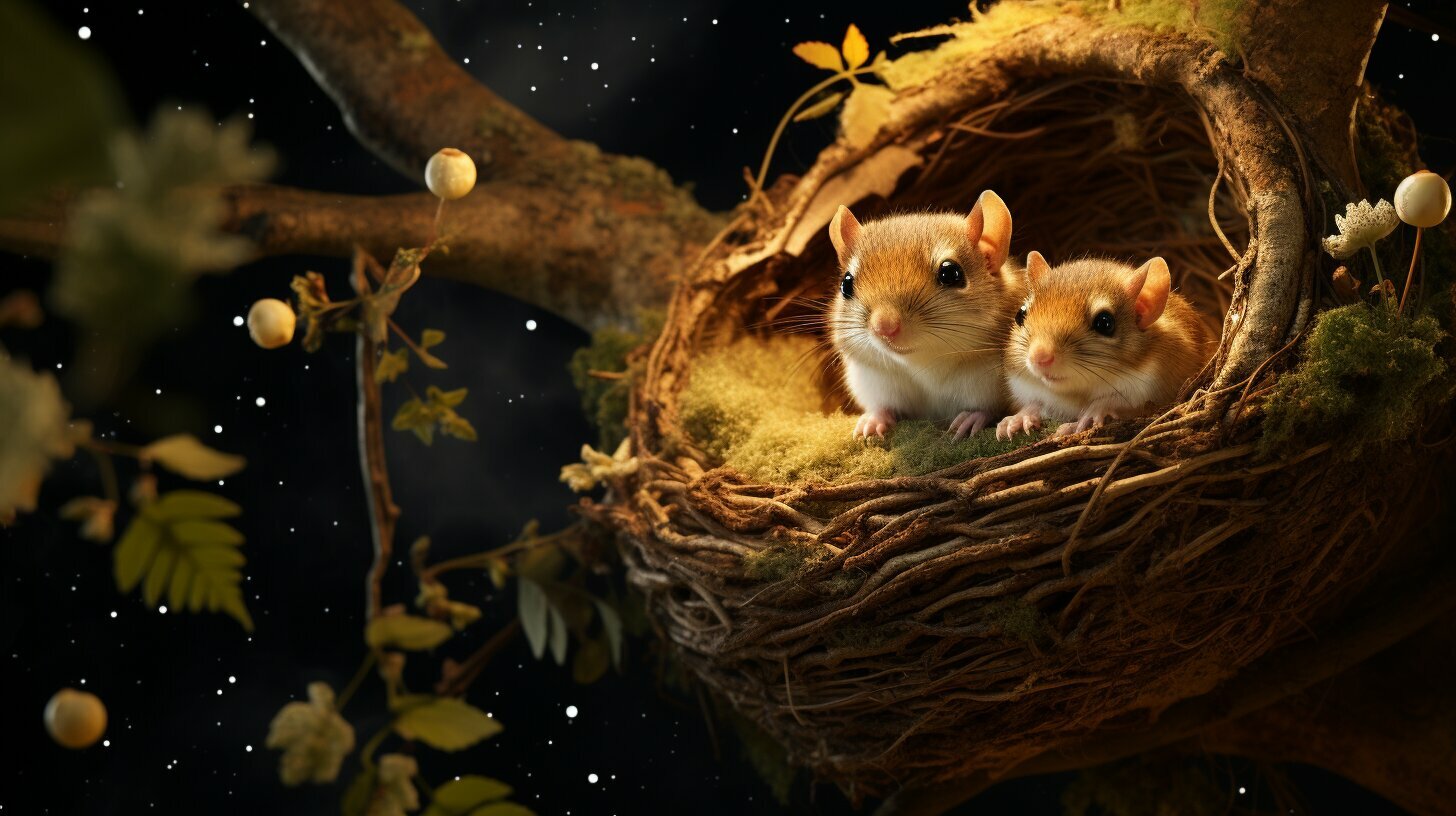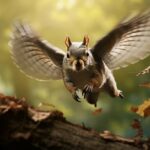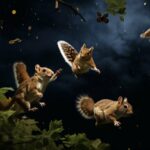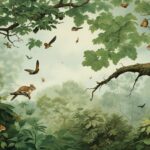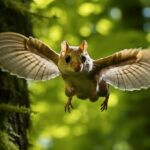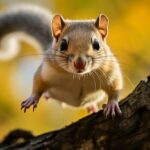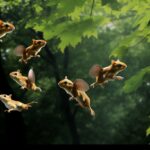Flying squirrels have captivating nesting habits that reveal their unique adaptations and behaviors. These nocturnal tree squirrels, known for their gliding abilities, are the smallest of all squirrels. In North America, you can find two species of flying squirrels: the Northern (Glaucomy sabrinus) and the Southern (Glaucomy volans).
While Northern adults measure about 10-12 inches, Southern flying squirrels are smaller, at about 8-10 inches. They don’t actually fly; instead, they glide through the air using a furry membrane called the patagium, which stretches between their front and rear legs. With this remarkable ability, flying squirrels can glide distances of 80-150 feet and expertly steer and brake using their tail as a stabilizer.
Preferred nesting habitats for these fascinating creatures are coniferous and mixed forests that produce nuts, such as maple, beech, hickory, oak, and poplar. However, they may also den in houses or barns. Flying squirrels require a large wooded area with close-spaced trees to navigate through without spending much time on the ground.
Key Takeaways:
- Flying squirrels are nocturnal gliding tree squirrels.
- North America is home to two species of flying squirrels: Northern and Southern.
- They don’t fly but glide through the air using a furry membrane called the patagium.
- Preferred nesting habitats include coniferous and mixed forests that produce nuts.
- Flying squirrels require a large wooded area with closely spaced trees.
Understanding Flying Squirrel Species and Gliding Abilities
Flying squirrels are nocturnal tree squirrels known for their impressive gliding abilities and specialized adaptations. They are the smallest of all squirrels and can be found in North America, with two species: the Northern (Glaucomy sabrinus) and the Southern (Glaucomy volans). Northern flying squirrels are larger, measuring around 10-12 inches, while Southern flying squirrels are smaller, averaging about 8-10 inches and having a more grayish appearance.
What sets flying squirrels apart from their terrestrial relatives is their unique method of locomotion. While they don’t actually fly, they can glide through the air. This is made possible by a furry membrane called the patagium, which stretches between their front and rear legs. With the patagium, flying squirrels can glide an impressive distance of 80-150 feet. To steer and brake during flight, they rely on their tail, using it as a stabilizer.
Flying squirrels have specific preferences when it comes to their habitat. They primarily inhabit coniferous and mixed forests that provide a plentiful supply of nuts, including maple, beech, hickory, oak, and poplar. Additionally, they may also find shelter in houses or barns. These agile creatures require a large wooded area with close-spaced trees to navigate through efficiently, minimizing their time spent on the ground.
| Nesting Behaviors | Description |
|---|---|
| Refugia nests | Nests used for temporary shelter and protection |
| Dreys | Nests built in tree cavities or dens |
| Food caches | Storing food provisions for future consumption |
These remarkable squirrels possess a diverse diet, consisting of hickory nuts, acorns, peanuts, pecans, sunflower seeds, fungi, lichens, mushrooms, tree sap, insects, carrion, bird eggs and nestlings, buds, and flowers.
Within their nesting behaviors, flying squirrels exhibit various nesting strategies. They construct refugia nests, dreys, natal nests, aggregate nests, defectatoriums (dens for defecation), and food caches. Flying squirrels are known to live in loose colonies, often sharing nests with related or unrelated individuals.
To further understand and appreciate flying squirrel nesting habits, continue reading the next section, which focuses on their preferred nesting habitats and behaviors.
Preferred Nesting Habitats and Nesting Behaviors
Flying squirrels choose specific habitats for nesting and exhibit various nesting behaviors to ensure their survival. These nocturnal tree squirrels prefer coniferous and mixed forests that produce an abundance of nuts such as maple, beech, hickory, oak, and poplar. The presence of these nuts provides a vital food source for flying squirrels.
While flying squirrels are known to build their nests in tree cavities, they can also den in houses or barns, particularly if suitable natural habitat is limited. To navigate through their habitat without spending significant time on the ground, flying squirrels require a large wooded area with close-spaced trees.
Flying squirrels exhibit various nesting behaviors, each serving a specific purpose. Refugia nests are used for resting during the day and are typically located in tree cavities, abandoned woodpecker holes, or even birdhouses. Dreys are dome-shaped nests made of twigs, leaves, and fur, often built high up in trees. Natal nests are where females give birth and care for their young, while aggregate nests house multiple individuals, both related and unrelated. Defectatoriums, or dens for defecation, are separate from their primary nests, ensuring hygiene within their living quarters. Finally, flying squirrels create food caches to store and secure their food supply.
Table 1: Flying Squirrel Nesting Behaviors
| Nesting Behavior | Description |
|---|---|
| Refugia Nests | Nests used for resting during the day, often located in tree cavities, abandoned woodpecker holes, or birdhouses. |
| Dreys | Dome-shaped nests made of twigs, leaves, and fur, built high up in trees. |
| Natal Nests | Nests where females give birth and care for their young. |
| Aggregate Nests | Nests that house multiple individuals, both related and unrelated. |
| Defectatoriums | Dens specifically used for defecation, separate from their primary nests. |
| Food Caches | Storage areas to secure and preserve their food supply. |
Understanding the nesting behaviors of flying squirrels is crucial for conservation efforts and ensuring their continued survival. By preserving their preferred habitats and providing suitable nesting options, we can help these fascinating creatures thrive in their natural environment.
Nestboxes and Nestbox Monitoring for Flying Squirrels
Nestboxes can play a crucial role in providing suitable nesting sites for flying squirrels, and monitoring them can offer valuable insights into their behavior and population dynamics. By providing these artificial nesting structures, you can help support the conservation efforts of these fascinating creatures.
When it comes to nestbox placement, it is important to consider the preferred habitat of flying squirrels. Choose a location within a large wooded area, preferably with close-spaced trees and a variety of nut-producing species like maple, beech, hickory, oak, and poplar. The nestbox should be placed at a height of 8-20 feet, ensuring the presence of tree cover to offer protection and camouflage.
To maximize the chances of attracting flying squirrels, it is recommended to scatter 3-5 nestboxes in a five or ten-acre area, and another 3-5 boxes in a 10-20 acre area about every mile or so. This distribution mimics the natural spacing of their nests in the wild and provides them with multiple options for suitable nesting sites.
| Nestbox Type | Entrance Size | Recommended Placement |
|---|---|---|
| Regular nestboxes | 7/8″ slot or 1.25″ round hole | 8-20 feet high in preferred habitat |
| Gourds | 7/8″ slot or 1.25″ round hole | 8-20 feet high in preferred habitat |
| Owl nestboxes | 7/8″ slot or 1.25″ round hole | 8-20 feet high in preferred habitat |
To monitor flying squirrels in the nestboxes, there are a few techniques you can employ. Lightly tapping on the box can encourage them to peek out, allowing you to observe their presence. Another method involves gently prodding the nesting material with a stick to provoke movement. By monitoring these artificial nests, you can gather important data about their occupancy, breeding habits, and overall population dynamics.
It is essential to clean out nestboxes when they are vacated, which typically occurs every two years. This maintenance ensures that the nestboxes remain hygienic and suitable for future occupants. Monitoring and cleaning nestboxes are essential steps toward creating a supportive environment for flying squirrels.
Conservation and Conclusion
While not listed as threatened species, flying squirrels face habitat loss as a potential threat, highlighting the need for conservation efforts. These remarkable creatures depend on coniferous and mixed forests that produce nuts, such as maple, beech, hickory, oak, and poplar. Preserving these habitats is crucial for the survival of these nocturnal wonders.
One approach to conservation is the use of nestboxes, which provide safe shelter and breeding grounds for flying squirrels. Regular nestboxes, gourds, and owl nestboxes can all be utilized to accommodate these small creatures. It is important to place the nestboxes in preferred habitats with ample tree cover, typically 8-20 feet high. By scattering multiple nestboxes in designated areas, we can increase the likelihood of attracting flying squirrels and promoting their population growth.
Monitoring flying squirrels in nestboxes is a valuable method for understanding their habits and behaviors. Tapping on the boxes or provoking movement with a stick can help researchers and enthusiasts observe these secretive creatures. Additionally, cleaning out the nestboxes when they are vacated ensures optimal nesting conditions for future inhabitants.
Table: Threats to Flying Squirrels
| Threat | Description |
|---|---|
| Habitat Loss | Due to deforestation and urbanization, flying squirrels are losing their natural habitats, putting their populations at risk. |
| Predation | Owls, hawks, tree snakes, and climbing mammals pose a threat to flying squirrels, as they are preyed upon in their natural environment. |
In conclusion, the nesting habits of flying squirrels are captivating and provide valuable insights into their survival strategies. As we appreciate their ability to glide through the air and adapt to various habitats, we must also recognize the importance of preserving their natural homes. By taking conservation actions such as creating nestboxes, monitoring populations, and mitigating threats like habitat loss, we can ensure a brighter future for these charming creatures.
Conclusion
Flying squirrels exhibit incredible nesting habits, showcasing their adaptability and resilience in their natural habitats. These nocturnal tree squirrels, known for their gliding abilities, are the smallest of all squirrel species found in North America. The Northern and Southern flying squirrels are the two species found in the region, with slight differences in size and coloration.
While they do not possess the ability to actually fly, flying squirrels can glide through the air using a furry membrane called the patagium that stretches between their front and rear legs. This adaptation enables them to cover distances of 80 to 150 feet, steering and braking with the help of their tail as a stabilizer.
Preferred nesting habitats for flying squirrels include coniferous and mixed forests that provide a variety of nuts, such as maple, beech, hickory, oak, and poplar. Additionally, they may seek refuge in human structures like houses or barns. However, they require large wooded areas with closely spaced trees to navigate their surroundings without spending much time on the ground.
These fascinating creatures have a diverse diet, consuming a wide range of food items including nuts, seeds, fungi, insects, carrion, and even bird eggs and nestlings. They exhibit different nesting behaviors, such as building various types of nests for different purposes, living in loose colonies, and occasionally sharing nests with related or unrelated individuals.
Nestboxes can be a useful tool in supporting flying squirrel populations. Regular nestboxes, gourds, or owl nestboxes can be utilized, with specific hole sizes to accommodate these small squirrels while keeping out predators. It is essential to place nestboxes in preferred habitat areas with ample tree cover, at optimal heights, and in strategic quantities to encourage their use.
Monitoring flying squirrels in nestboxes can be done by gently tapping on the boxes to provoke movement or prodding the nesting material with a stick. Cleaning out nestboxes when they become vacant is crucial for maintaining optimal nesting conditions for future use.
While flying squirrels are not currently listed as threatened species, habitat loss poses a potential threat to their populations. Predation by owls, hawks, tree snakes, and climbing mammals also plays a role in their survival. Therefore, the conservation and preservation of their habitats are of paramount importance in ensuring the continued existence of these remarkable creatures.
In conclusion, exploring the nesting habits of flying squirrels provides a captivating glimpse into the world of these nocturnal wonders. Their gliding abilities and unique behaviors make them a truly enchanting addition to our natural ecosystems.
How Does Flying Squirrel Communication Assist with Nesting Habits?
Flying squirrel communication: nature’s hidden language plays a crucial role in the nesting habits of these unique animals. Through vocalizations, scent marking, and intricate body language, these squirrels convey important messages to their counterparts. By sharing information about potential threats, food availability, and suitable nesting sites, this communication system enhances their chances of survival and successful reproduction. It allows for effective coordination among colony members, ensuring the well-being and efficiency of their nesting activities.
FAQ
Q: Are flying squirrels actually capable of flying?
A: No, flying squirrels do not fly in the traditional sense. They glide through the air using a furry membrane called the patagium, which stretches between their front and rear legs.
Q: How far can flying squirrels glide?
A: Flying squirrels can glide distances of 80-150 feet through the air.
Q: What do flying squirrels eat?
A: Flying squirrels have a varied diet, including hickory nuts, acorns, peanuts, pecans, sunflower seeds, fungi, lichens, mushrooms, tree sap, insects, carrion, bird eggs and nestlings, buds, and flowers.
Q: Where do flying squirrels prefer to nest?
A: Flying squirrels prefer nesting habitats in coniferous and mixed forests that produce nuts such as maple, beech, hickory, oak, and poplar. They may also den in houses or barns.
Q: How do you attract flying squirrels to nestboxes?
A: To attract flying squirrels to nestboxes, place them in preferred habitat with tree cover, preferably 8-20 feet high. It is recommended to place multiple nestboxes scattered in specific areas to increase their chances of finding them.
Q: How can I monitor flying squirrels in nestboxes?
A: You can monitor flying squirrels in nestboxes by tapping on the box to get them to peek out or prodding the nesting material with a stick to provoke movement. Clean out nestboxes when they are vacated, which may occur every two years.
Q: Are flying squirrels endangered?
A: Flying squirrels are not listed as threatened species, but habitat loss is a potential threat to their populations. They are also preyed upon by owls, hawks, tree snakes, and climbing mammals.

